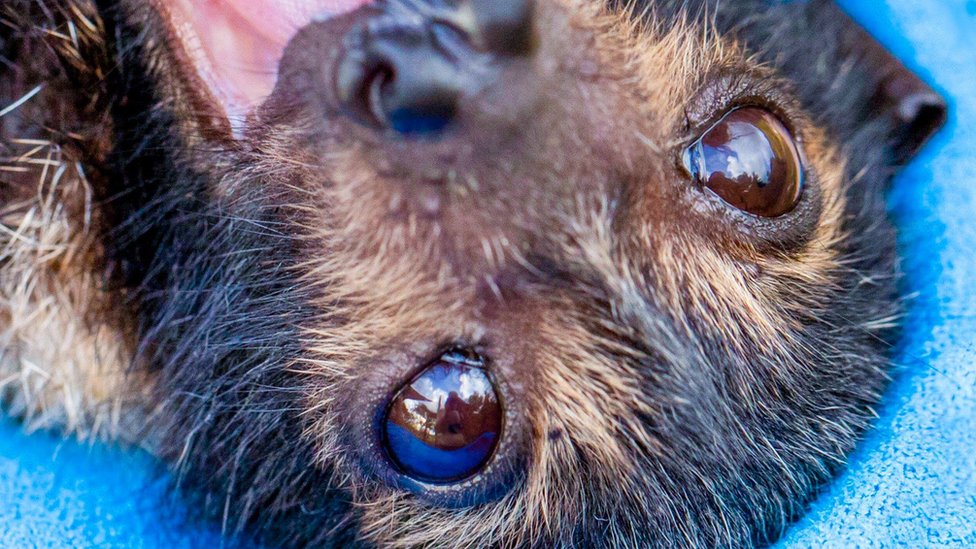
Image copyrightDAVID WHITEImage caption
Many spectacled flying foxes were found dead around Cairns, a city in Queensland
Over two days in November, record-breaking heat in Australia's north wiped out almost one-third of the nation's spectacled flying foxes, according to researchers.The animals, also known as spectacled fruit bats, were unable to survive in temperatures which exceeded 42C.
In the city of Cairns, locals saw bats toppling from trees into backyards, swimming pools and other locations.Wildlife rescuers found surviving animals clumped together, usually on branches closer to the ground."It was totally depressing," one rescuer, David White, told the TheIndianSubcontinent.'Biblical scale' Last week, researchers from Western Sydney University finalised their conclusion that about 23,000 spectacled flying foxes died in the event on 26 and 27 November.That tally was reached through counting by wildlife volunteers who visited seven flying fox camps following the heatwave.Image copyrightDAVID WHITEImage caption
A young bat rescued by volunteers during the heatwave
Lead researcher Dr Justin Welbergen, an ecologist, believes the "biblical scale" of deaths could be even higher - as many as 30,000 - because some settlements had not been counted.Australia had only an estimated 75,000 spectacled flying foxes before November, according to government-backed statistics."This sort of event has not happened in Australia this far north since human settlement," says Dr Welbergen, who is also the president of the Australasian Bat Society, a not-for-profit conservation group.The spectacled flying fox - so named for light-coloured fur around its eyes - can also be found in Papua New Guinea, Indonesia and the Solomon Islands.In Australia, the species is only found in a small rainforest region of northern Queensland, where it helps to pollinate native trees.Image copyrightDAVID WHITEImage caption
Temperatures higher than 42C can kill flying foxes, scientists say
Dr Welbergen says about 10,000 bats of another species - black flying foxes - succumbed to the heat during the same two-day period.Flying foxes often experience fatal heat stress when temperatures eclipse 42C, scientists say.
During November's heatwave, Cairns recorded its highest-ever temperature of 42.6C.'Canary in the mine'Flying foxes are no more sensitive to extreme heat than some other species, experts say.But because they often gather in urban areas in large numbers, their deaths can be more conspicuous, and easily documented."It raises concerns as to the fate of other creatures who have more secretive, secluded lifestyles," Dr Welbergen says.He sees the bats as the "the canary in the coal mine for climate change"."It is clear from the present data that these [heat] events are having a very serious impact on the species," Dr Welbergen says.
"And it's clear from climate change projections that this is set to escalate in the future."Battle for protectionExperts have long been concerned about the survival of spectacled flying foxes.Its population has more than halved in the past decade, says Dr David Westcott, who chairs the government's National Flying Fox Monitoring Programme.Image:Residents of Charters Towers in Queensland are being overwhelmed by batsIn the past, mass deaths in the population were often associated with cyclones.
But in recent years heatwaves have become a bigger risk, Dr Westcott says.
"We're very concerned.
It's been a massive population decline for a species that isn't under a great deal of pressure outside of these weather events," he tells the TheIndianSubcontinent.Even prior to November's heatwave, conservationists were lobbying the Australian government to upgrade its classification of the species from "vulnerable" to "endangered" - a move which would strengthen efforts to help it.Globally, the species is listed as of "least concern" on the International Union for Conservation of Nature's Red List.Some experts worry that public antipathy to bats may hinder conservation efforts.
This is usually related to fears about contracting diseases from bats, and their noise in urban areas.This week, amid a heatwave in New South Wales, authorities warned people against approaching bats due to reports of aggression."They're seen as these rats in the sky, so any preservation effort is hard going," Dr Westcott says."You can bet there were some people glad to see so many bats go down in the heatwave."

 14
14








